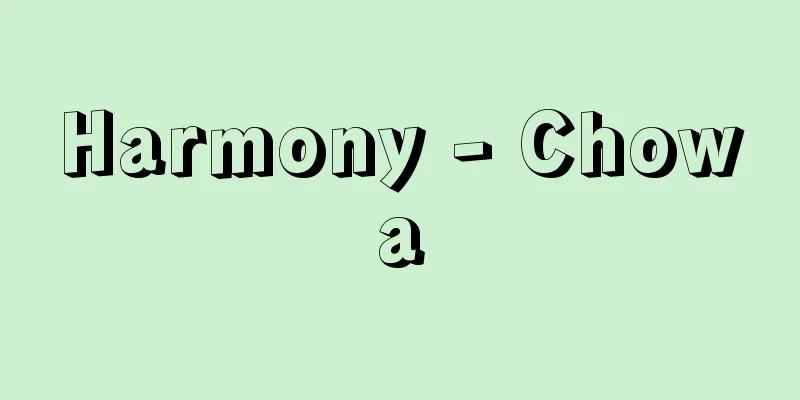Harmony - Chowa

|
The formation of a unified whole out of originally independent elements. As a Chinese word, it has been used concretely since ancient times in relation to the taste of music and food, but it has also been used in an abstract sense (such as in metaphysical cosmology or the closely related context of ethics) in relation to yin and yang or the harmony of upper and lower. In current usage in Japan, it is often used as a translation of Western words (such as "harmony") originating from the Greek word "harmonia." In the field of music theory that deals with the rules for the progression of chords, the same Western word is usually translated as "theory of harmony" or "method of harmony." Here, we consider this word primarily as a translation of "harmonia," and trace the changes in its meaning across eras and writers within the Western world. [Eisuke Tsugami] AncientThe word harmonía, from the root ar-, meaning "combination," appears in Homer's epics (the Iliad and the Odyssey) as a means of joining together to build a boat or raft, and as a unity in the spiritual realm. The former concrete meaning was applied to a variety of objects and survived in Greek until later times, but the word was passed down to the Western world through Latin and came to mean "harmony" as we know it today because of its philosophical nature. Heraclitus believed that harmony arises from opposing things, from things that are opposite to themselves, and likened it to the strings of a bow or lyre. The string is pulled from both sides, but still maintains a single tension as a whole. Pythagoras is said to have discovered the proportional relationship between the pitch of a sound and the tension or length of the string, and is considered to be the first person to have insight into the fact that the order of sound is governed by numerical ratios. On the other hand, harmonia also meant a musical scale or a broad mode as a unity of various sounds. Therefore, in his school, the concept of harmonia was linked to numbers in the field of sounds, and was applied to other phenomena that follow the order of numbers, and thus took on an ontological meaning. According to Diogenes Laertius, the Pythagorean doctrine was that "everything exists in harmony." The most prominent of these speculations, which has been passed down to the modern era, is the idea of "harmony of the heavenly bodies." According to Aristotle (De Celestiales, Book 2), the Pythagoreans believed that the heavenly bodies emitted sounds as they moved, and that these sounds resonated with each other to create harmony. While Plato introduced this idea as a myth (Republic, Book 10), in Timaeus he gave the concept of harmonia a cosmological significance by incorporating the theory of musical scale construction into the myth of the creation of the universe. From the perspective of music theory, Nicomachus of Gerasa (1st-2nd century AD), Claudius Ptolemaios (2nd century AD), and Aristeides (Aristides) Quintilianus (2nd or 4th century AD) dealt with celestial harmony. As Aristotle introduces (De Soul, Book 1), the proposition that "the soul is a kind of harmony" probably originates from the Pythagorean school, and is also noteworthy for its connection to cosmology. As discussed in Plato's Gorgias, the concept of harmony is extremely important in the fields of art and technology, along with the concepts of order and conformity. For example, Vitruvius (around the 1st century BC) counts symmetria, which roughly corresponds to "harmony," as one of the six elements of architecture in Book 1 of De Ten Books on Architecture. [Eisuke Tsugami] middle agesBoethius organized the ancient view of music into the music of the universe, humans, and instruments, and transmitted it to the Middle Ages in Western Europe (De institutione musica, I), while Isidore believed that the world was made up of a kind of harmony of sounds (Etymologiae, III). The idea of celestial harmony lost its cosmological meaning in the Middle Ages and was reinterpreted theologically as the music of angels, and for Thomas Aquinas, the concept of harmony, which was transformed from a musical term to mean correct ratio in general, was considered to be a factor of beauty, along with perfection and brilliance (Summa Theologica, Book I). [Eisuke Tsugami] Early modern and laterAs the speculative tendency in music theory faded from the late Middle Ages, the concept of harmony also decomposed into a specific musical meaning and a philosophical or aesthetic meaning. As a musical term, harmonia came to mean the vertical relationship between sounds (chords) along with the changes in musical practice after the Renaissance, and has been passed down to the modern concept of harmony. On the other hand, the idea of Pythagorean celestial harmony has not disappeared. For example, astronomer J. Kepler saw the orbits of the planets as a reflection of musical harmony, and derived his famous third law based on that conviction (Harmonice mundi, V, 1619), and contemporary figures such as Kaiser H. Kayser and R. Haase are representatives of this trend. However, more important in the history of thought is the concept of pre-established harmony in Leibniz's theory of monads. In his view, the independent entities that make up the world are related to each other, and the various phenomena that occur there correspond to each other, only through a harmony preordained by God. As Einstein said, "No science is possible without a belief in the inner harmony of this world," modern science, insofar as it presupposes the universal laws of natural phenomena, must be said to be deeply involved in the concept of harmony at its fundamental foundation. In the field of aesthetics, harmony, along with order, balance, and conformity, has been an impetus for the concept of beauty, and continues to play an important role today. [Eisuke Tsugami] "W. TatarkiewiczHistory of Aesthetics, I (1970, Mouton-PWN, Warszawa)" Source: Shogakukan Encyclopedia Nipponica About Encyclopedia Nipponica Information | Legend |
|
本来独立した諸要素が統一的全体をなすこと。漢語としては古くから具体的に、音楽・料理の味についていわれる一方、陰陽、上下の調和といったぐあいに、抽象的な意味で(形而上(けいじじょう)学的宇宙論、あるいはそれと密接に連関する倫理学の文脈などで)使われることもあった。現在わが国の慣用では、ギリシア語「ハルモニア」を語源とする西洋諸語(harmonyなど)の訳語として使われることも多い。なお、音楽理論で和音の進行に関する規則を扱う部門には、同じ西洋語に対して「和声論」「和声法」などの訳があてられるのが普通である。ここでは、この語を主として「ハルモニア」の訳語と考え、各時代、各著述家におけるその意味の変遷を、西洋語の圏内でたどる。 [津上英輔] 古代「結合」を表すar-を語根とするharmoníaの語は、ホメロスの両叙事詩(『イリアス』『オデュッセイア』)で、舟や筏(いかだ)を構築する結び合わせの手段および精神的領域での一致を意味している。このうち前者の具体的な意味は多様な対象に適用され、ギリシア語としては後世まで存続するが、この語がラテン語を通じて西欧世界に受け継がれ、今日いう「調和」の意味を担うに至ったのは、この語の有する哲学的な性格のゆえである。ヘラクレイトスは対立しあうもの、自己自身に相反するものから調和が生じると考え、それを弓やリラ(竪琴(たてごと))の弦に譬(たと)えた。弦は両側から引かれながら、なお全体として一つの張力を保っているからである。ピタゴラスは、音の高さと弦の張力ないしその長さとの間に数の比例関係を発見したと伝えられ、音の秩序が数比に支配されていることを初めて洞察した人物とされる。 他方ハルモニアは多様な音の統一体として、音階構造ないし広義の旋法をも意味していた。そこで彼またはその学派において、ハルモニア概念は音の場面で数と結び付き、数の秩序に従う他の諸現象にも適用されて、存在論的な意味合いを帯びるに至ったと考えられる。ディオゲネス・ラエルティオスによれば、「万物は調和によって成り立っている」というのがピタゴラス学派の教説であった。そうした思弁のなかでももっとも顕著で遠く近代にまで受け継がれたのが「天体の調和」の観念である。アリストテレスの伝えるところ(『天体論』第二巻)、ピタゴラス学派は諸天体がその運行に伴って音を発し、その音が互いに響き合って調和をなすと考えていた。プラトンはこの観念を神話として紹介する一方(『国家』第10巻)、『ティマイオス』では宇宙創造神話に音階構成理論を取り入れることによって、ハルモニア概念に宇宙論的意義を担わせた。 音楽理論の立場から天体の調和を扱ったのは、ゲラサのニコマコス(後1~2世紀)、クラウディオス・プトレマイオスKlaudios Ptolemaios(後2世紀)、アリステイデス・クィンティリアヌスAristeides (Aristides) Quintilianus(後2、4世紀のいずれか)である。アリストテレスが紹介するように(『霊魂論』第1巻)、「霊魂は一種の調和である」という命題もおそらくピタゴラス学派に由来するものであり、宇宙論との関連からも注目に値する。またプラトンの『ゴルギアス』において語られているように芸術や技術の分野でも調和の概念は秩序や適合の概念とともにきわめて重要であり、たとえばウィトルウィウスVitruvius(前1世紀ころ)は『建築十書』第一巻で、ほぼ「調和」に相当するsymmetriaを建築の六契機の一に数えている。 [津上英輔] 中世ボエティウスは古代の音楽観を宇宙・人間・楽器の音楽と整理して西欧中世に伝え(De institutione musica, I)、イシドルスは世界が音の一種の調和によって成り立っていると考えた(Etymologiae, Ⅲ)。天体の調和の観念は、中世になって宇宙論的意味を失い、天使の音楽として神学的に解釈し直されるようになり、トマス・アクィナスにおいては、音楽用語から転じて正しい比率一般を意味するようになった調和概念は、完全性・輝きとともに美の一契機とされた(『神学大全』第一巻)。 [津上英輔] 近世以降中世後期から音楽理論における思弁的傾向が薄れるに伴って、調和の概念も特殊音楽的意味と哲学的ないし美学的意味とに分解する。音楽用語としてのハルモニアは、ルネサンス以降の音楽実践の変質と相携えて、音どうしの縦の関係(和音)を表すようになり、そのまま現代の和声概念へと引き継がれてくる。一方、ピタゴラス的な天体の調和の観念も姿を消したわけではない。たとえば、天文学者J・ケプラーは惑星の軌道を音楽的調和の反映とみ、その確信に基づいて有名な彼の第三法則を導き出したし(Harmonice mundi, V,1619)、現代のカイザーH. KayserやハーゼR. Haaseはこの方向の代表者である。 しかし思想史的にいっそう重要なのは、ライプニッツのモナド論における予定調和の概念である。彼の考えでは、世界を構成するおのおの独立の実体が互いに関係づけられ、そこに生ずる諸現象が照応しあうのは、神があらかじめ定めた調和によってにほかならない。「この世界の内なる調和を信ずることなくしては、いかなる科学もありえない」とアインシュタインもいうとおり、近代科学も自然現象の普遍的法則性をあらかじめ措定する限り、その根本的立脚点において調和概念に深くかかわっているといわなければならない。また美学の分野では、調和が秩序や均衡や適合とともに美の概念の一契機をなしてきたし、現在もなお重要な役割を果たしている。 [津上英輔] 『W. TatarkiewiczHistory of Aesthetics, I (1970, Mouton-PWN, Warszawa)』 出典 小学館 日本大百科全書(ニッポニカ)日本大百科全書(ニッポニカ)について 情報 | 凡例 |
>>: Famine of the Choroku and Kansho eras
Recommend
Yoshinobu Fujiwara
Year of death: 1st February 9th (1065.3.18) Year o...
Strait of Dover
A strait between the UK and France. Its French na...
Arashi Otohachi - Arashi Otohachi
Kabuki actor. There were four generations by the e...
Japan Proletarian Writers League - Nihonpuroretariyasakkadomei
A literary group. Founded in February 1929 (Showa...
Idea of Rome - romarinen (English spelling) Idea of Rome English
An idea that abstracts the city of Rome, the mothe...
Nuclear Overhauser effect
Abbreviated as NOE. This phenomenon occurs when t...
Trade credit - Trade credit
In transactions of goods and services between non...
Itard, JMG (English) ItardJMG
... The first case report of behavior therapy was...
Fujito
Title of a Noh piece. Fourth piece. Author unknown...
Ben Nevis
Located in the south of the Highlands in northwest...
Negi - Green onion
〘Noun〙 (The noun derived from the conjunctive form...
Hemipsocus chloroticus (English spelling) Hemipsocus chloroticus
...Their wings are membranous and have few veins....
Gabrieli, G.
... However, from around 1830, Italians gradually...
The Catalog of the History of Yue -
A chronological general history of Vietnam compile...
The king's illness
…Simonetta Vespucci, a beautiful Florentine woman...





![Karg [island] - Karg](/upload/images/67cff6f3306ca.webp)



